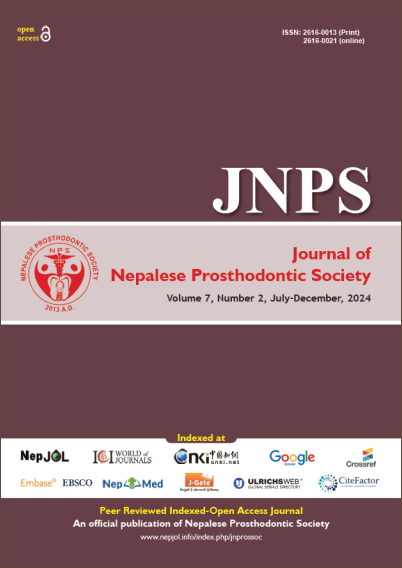Vertical Distance Between the Lingual Frenum and Incisal Edge of Mandibular Incisors: An Aid to Establish Mandibular Occlusal Plane
DOI:
https://doi.org/10.3126/jnprossoc.v7i2.77555Keywords:
Lingual frenal attachment, Mandibular incisors, Occlusal planeAbstract
Introduction: This study evaluated the reliability of measuring the distance between the anterior attachment of the lingual frenum and the incisal edges of the mandibular incisors, on casts, to be utilized as a preextraction record for determining the vertical position of the mandibular incisors in complete denture patients.
Materials and Methods: Two hundred and ten dentulous subjects within the age range of 18-25 years, exhibiting Class I dental relationships and without prior orthodontic treatment, were selected for this study. A mandibular cast was fabricated from irreversible hydrocolloid impression material in metal stock trays for each participant. All subjects were instructed to elevate their tongues during the impression-taking process. The vertical distance between the anterior attachment of the lingual frenum and the incisal edges of mandibular central incisors was measured on the casts using a digital vernier caliper. Means and standard deviations of the measurements were calculated and subjected to statistical analysis using SPSS 20.0 software.
Results: The distance between the anterior attachment of the lingual frenum and incisal edges of mandibular central incisors among the 210 subjects was 11.79mm ± 1.36 mm. In males it ranged from 9.11 to 14.62 mm with mean (±SD) 11.81 ± 1.39 mm while in females it ranged from 9.25 to 14.36 mm with mean (±SD) 11.76 ± 1.34 mm.
Conclusion: The distance between the incisal edge of mandibular central incisor and the anterior attachment of lingual frenum may be used as a reliable land marks to determine occlusal vertical dimension.
Downloads
Downloads
Published
How to Cite
Issue
Section
License
Copyright (c) 2024 The Author(s)

This work is licensed under a Creative Commons Attribution-NonCommercial-NoDerivatives 4.0 International License.
This license enables reusers to distribute, remix, adapt, and build upon the material in any medium or format, so long as attribution is given to the creator. © The authors




